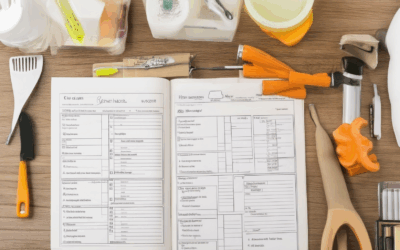Homeownership comes with its fair share of challenges, from unexpected breakdowns to minor repairs that seem to pop up at the most inconvenient times. Even the most seasoned homeowners may find themselves struggling with simple fixes, leaving them feeling overwhelmed and seeking reliable solutions. Whether it’s a leaky pipe, a wobbly chair, or a malfunctioning appliance, having quick and effective DIY repair tips can transform your approach to household maintenance. In this guide, we’ll explore essential strategies and tools that every homeowner should know, helping you tackle common issues with confidence and ease. From time-saving techniques to preventing future problems, discover how to master minor repairs with ease, ensuring your home stays in top shape year-round.
Key Takeaways
- Address Minor Plumbing Leaks: Quickly fix leaks to prevent water damage and costly repairs.
- Maintain Gutters: Regularly clean and inspect gutters to avoid water buildup and clogs.
- Check for Mold Growth: Conduct mold inspections to ensure a safe and healthy living environment.
- Inspect HVAC Systems: Regularly service your heating and cooling systems for optimal performance and energy efficiency.
- Pest Control Checks: Routinely inspect for pests like termites to protect your home from structural damage.
- Ensure Safety Devices: Test smoke detectors and fire extinguishers to maintain emergency preparedness.
- Lead Paint and Hazard Checks: Inspect for lead paint and other potential hazards to ensure your home’s safety.
- Regular Appliance Checks: Schedule maintenance for major appliances to prevent breakdowns and ensure reliable operation.
- Gutter and Drain Maintenance: Keep gutters clear and drains flowing to prevent water damage and clogs.
- Mold and Moisture Control: Address mold issues and ensure proper ventilation to maintain a healthy home environment.

Top 10 Easiest DIY Repair Tips for Homeowners
- Fix Leaky Faucets: Replace the washer in your faucet to stop drips. Most faucet issues can be resolved with a simple screwdriver and standard replacement parts.
- Patch Small Holes in Walls: Use spackling compound to fill small cracks or holes. Sand smooth and paint over for a seamless fix.
- Clean and Unblock Drains: Use a drain cleaner or a mixture of baking soda and vinegar to clear clogs. Avoid chemical drain cleaners for better safety.
- Replace a Burner Element: If your stove’s burner isn’t working, unscrew and replace the faulty element with a new one from your local hardware store.
- Fix Wobbly Chairs: Tighten loose screws on chair legs or adjust the height using a wrench to ensure stability.
- Clear Clogged Gutters: Remove debris like leaves and twigs using gloves and a ladder. Keep gutters clear to prevent water damage.
- Repair Scuffed Floors: Apply a scratch cover stick-on patches to hide minor scratches. For deeper scratches, consider refinishing or repainting the floor.
- Adjust Loose Cabinet Handles: Use a screwdriver to tighten wobbly handles or replace them if necessary for better alignment.
- Fix a Sticky Door or Window: Lubricate hinges with silicone-based spray to reduce sticking. Adjust the door or window frame if necessary for better fit.
- Replace a Blown Fuse Box Cover: If the fuse box cover is damaged, remove it and install a new one from the hardware store. Take care to disconnect power before handling fuses.
Brought to you by Sams Maintenance , your trusted source for home repair guidance. Explore our DIY repair guides and project ideas for more expert tips!
What Are the Easiest Ways for Homeowners to Handle Minor Repairs?
Handling minor repairs around the house can be made easier with the right approach and preparation. Here are some practical tips:
- Create a Repair Kit: Keep a well-stocked tool kit nearby, including essentials like a screwdriver, pliers, tape measure, and basic fasteners. This saves time and prevents last-minute trips to the hardware store.
- Learn Basic DIY Skills: Mastering simple tasks like fixing a leaky faucet, patching a wall, or replacing a light bulb can save both time and money. Many resources online offer step-by-step guides tailored for homeowners.
- Use Online Resources: Websites like SamsMaintenance.com provide detailed guides and videos for common repairs, making it easier to tackle minor fixes confidently.
- Know When to Call a Professional: While many minor repairs are manageable DIY projects, certain tasks like electrical wiring or plumbing require expertise. Knowing when to seek professional help ensures safety and efficiency.
- Stay Organized: Keep track of your tools and supplies in a designated area to reduce stress during repairs. A clean workspace makes any task easier to accomplish.
By preparing ahead and utilizing available resources, homeowners can manage minor repairs efficiently and effectively. Remember to check for seasonal maintenance needs and address issues early to prevent bigger problems down the line.

Top 10 Easiest DIY Repair Tips for Homeowners
- Fix Leaky Faucets: Replace the washer in your faucet to stop drips. Most faucet issues can be resolved with a simple screwdriver and standard replacement parts.
- Patch Small Holes in Walls: Use spackling compound to fill small cracks or holes. Sand smooth and paint over for a seamless fix.
- Clean and Unblock Drains: Use a drain cleaner or a mixture of baking soda and vinegar to clear clogs. Avoid chemical drain cleaners for better safety.
- Replace a Burner Element: If your stove’s burner isn’t working, unscrew and replace the faulty element with a new one from your local hardware store.
- Fix Wobbly Chairs: Tighten loose screws on chair legs or adjust the height using a wrench to ensure stability.
- Clear Clogged Gutters: Remove debris like leaves and twigs using gloves and a ladder. Keep gutters clear to prevent water damage.
- Repair Scuffed Floors: Apply a scratch cover stick-on patches to hide minor scratches. For deeper scratches, consider refinishing or repainting the floor.
- Adjust Loose Cabinet Handles: Use a screwdriver to tighten wobbly handles or replace them if necessary for better alignment.
- Fix a Sticky Door or Window: Lubricate hinges with silicone-based spray to reduce sticking. Adjust the door or window frame if necessary for better fit.
- Replace a Blown Fuse Box Cover: If the fuse box cover is damaged, remove it and install a new one from the hardware store. Take care to disconnect power before handling fuses.
Brought to you by Sams Maintenance , your trusted source for home repair guidance. Explore our DIY repair guides and project ideas for more expert tips!

How Can Homeowners Easily Fix Common Issues Around the House?
Homeownership requires regular maintenance to keep everything in great shape. Here are some simple solutions for common household issues:
- Leaky Pipes or Faucets : Turn off the water supply, disassemble the fixture, and replace the washer or O-ring. Reassemble and turn the water back on to check for leaks.
- Broken Tiles : Gently remove the broken tile by prying it up with a utility knife or hammer. Clean the area and apply adhesive to secure the replacement tile in place.
- Clogged Gutters : Use a ladder to access the gutter and remove any debris. Pour water through the system to ensure it flows freely. Consider installing gutter guards to prevent future clogs.
- Fading Paint : Test a small area by applying a fresh coat of paint. If it adheres well, proceed with repainting the entire surface. For wood surfaces, consider refinishing or staining instead.
- Loose Cabinet Handles : Remove the handle and screw it tightly into place. If it’s still loose, replace the screws or the handle itself.
- Dripping Ceiling Fans : Inspect the ceiling fan for loose connections. Tighten any wobbly parts and check for frayed wires or damaged switches.
- Scratched Appliance Surfaces : Apply a polishing cleaner or gentle abrasive to buff out scratches. For stainless steel, use a specifically designed cleaner to restore shine.
- Mold Spots : Mix a solution of bleach and water. Soak a clean cloth and lightly scrub the affected areas. Rinse thoroughly and dry the surface completely to prevent recurrence.
- Worn-out Rugs : Flip the rug to expose the underside and shake it vigorously. Use a vacuum or broom to remove dust and dirt before laying it flat again.
- Sticky Door Locks : Spray the lock with a silicone-based lubricant. Disassemble the lock if necessary and clean away any debris. Reassemble and test the lock to ensure smooth operation.
For more detailed guides and professional advice, visit our Home Maintenance Guide . Our resources cover everything from minor repairs to seasonal preparation, helping you keep your home in top shape year-round.
Easy Repair Tips for Homeowners
Keeping your home in great shape doesn’t have to be overwhelming. With a few simple tricks and tools, you can tackle many common repairs yourself. Here are some quick fixes to help you maintain your living space:
- Fix Leaky Pipes Quickly: Turn off the water supply, locate the leak, and replace the worn-out washer or pipe. Use an adjustable wrench to tighten connections. Always replace washers if they’re cracked or worn.
- Clean Clogged Drains: Use a plunger to clear slow-moving drains. If that doesn’t work, try a drain cleaner, but always follow safety guidelines. Avoid chemical drain cleaners if you’re unsure.
- Address Electrical Issues: Replace blown fuses or tripped circuit breakers by resetting them. If you suspect wiring issues, contact a licensed electrician to inspect and repair safely.
- Check HVAC Systems: Ensure vents and ducts are clean and free of obstructions. Replace air filters regularly to maintain efficiency. If your system isn’t heating or cooling effectively, consult a professional for servicing.
- Fix Plumbing Leaks: Turn off the water and inspect for visible leaks around pipes or fixtures. Use sealant or epoxy for small cracks. For larger issues, call a plumber to handle the repair.
- Repair Furniture Scratches: Apply a commercial furniture polish or a mixture of warm water and vinegar to remove light scratches. For deeper scratches, consider refinishing or replacing the piece if beyond repairable damage.
- Appliance Malfunction: Unplug appliances before troubleshooting. Check for obvious issues like empty error screens or blocked vents. Refer to manufacturer manuals for specific troubleshooting steps. Call a technician if you can’t resolve it yourself.
- Adjust Sticky Doors: Lubricate door hinges with silicone-based spray or petroleum jelly. Check for loose screws or misaligned frames causing the issue. Gently realign if necessary.
- Fix Windows and Screens: Clean tracks and frames to ensure smooth operation. Replace screens if torn or damaged. For double-hung windows, adjust the balance to maintain equal opening.
- Gutter Maintenance: Clear debris and check for leaks or sagging. Tighten loose hangers and repair any holes to prevent water damage. Consider installing gutter guards to reduce future maintenance.
For more advanced repairs or safety concerns, always consult a professional. Regular maintenance can save you time and money in the long run. Keep these tips handy to handle minor issues before they become major problems!

Easy Repair Tips for Homeowners
- Bleeding Brakes: Regularly check and bleed your brakes to ensure they function properly. This involves squeezing the brake lever and letting the brake fluid flow through the lines until no resistance is felt.
- Fixing Leaky Pipes: Address small plumbing leaks immediately to prevent water damage. Turn off the water supply, locate the leak, and replace the faulty pipe or fitting with materials suited for your home’s plumbing system.
- Replacing Burner Elements: If your gas stove’s burner isn’t heating evenly, unscrew and replace the faulty element. Clean the vent hood to ensure proper airflow and prevent future issues.
- Fixing Small Holes in Drywall: For minor cracks or holes in walls, apply spackling compound and sand smooth. Repaint the area to maintain a seamless look.
- Cleaning and Lubricating Doors: Remove and clean sliding door tracks. Apply a silicone-based lubricant to ensure smooth operation and prevent sticking.
- Adjusting Loose Cabinet Handles: Tighten wobbly cabinet handles by adjusting the screws and ensuring they’re snug against the wall.
- Checking and Replacing HVAC Filters: Regularly inspect air filters and replace them as needed to maintain efficient heating and cooling. This can prevent energy loss and extend appliance life.
- Inspecting for Trip Hazards: Look for loose rugs, cords, or objects that could cause trips. Secure them or remove them to ensure safety in high-traffic areas.
- Testing Smoke Detectors: Periodically test smoke detectors to ensure they’re functioning properly. Replace batteries as needed to maintain protection.
- Sealing Gutter Downspouts: Clear out gutters and ensure downspouts are free of debris. Consider sealing them to prevent leaks and water damage.
- Checking for Pest Damage: Inspect wooden surfaces for signs of pests like termites or carpenter bees. Treat affected areas promptly to prevent structural damage.
- Adjusting Water Pressure: If water pressure is low, check for blockages in pipes or aerators. Adjust the pressure regulator to maintain optimal flow without damaging fixtures.
- Testing Light Switches and Outlets: Flip switches to ensure lights and outlets are working properly. Replace any that are flickering or dead to prevent electrical issues.
- Inspecting Roof Vents: Clean roof vents to ensure proper airflow and prevent moisture buildup, which can lead to mold growth or damaged shingles.
- Checking for Loose Tiles: Inspect ceiling tiles for looseness or discoloration. Secure them or replace as needed to maintain a safe and stable environment.
- Testing Window Screens: Remove and clean window screens to ensure they’re free of tears or obstructions. Replace screens that are beyond repair to keep windows operating smoothly.
- Adjusting Blinds or Curtains: Ensure blinds or curtains are balanced and secure. Adjust them regularly to maintain privacy and light control.
- Inspecting Fire Extinguishers: Check expiration dates and functionality of fire extinguishers. Replace old or damaged units to prepare for emergencies.
- Checking for Gas Leaks: Use a detector to scan for gas leaks around appliances. If detected, turn off the gas and contact a professional for repairs.
- Testing Appliance Functionality: Run major appliances like refrigerators, ovens, and washers to ensure they’re functioning correctly. Replace outdated models to improve efficiency and reliability.
- Inspecting Driveways and Walkways: Look for cracks or uneven surfaces in driveways and walkways. Repair them to prevent tripping hazards and structural damage.
- Checking for Dead Trees: Inspect trees near your home for dead branches or disease. Trim them to reduce the risk of falling limbs and damage to property.
- Testing Outdoor Lighting: Ensure outdoor lights are working properly. Replace bulbs that are dimming or flickering to maintain safety and visibility.
- Inspecting Deck Safety: Check deck boards for warping or rot. Replace any that are unsafe and ensure railings are secure to prevent accidents.
- Checking for Pool or Spa Issues: Test pool pumps and filters to ensure they’re running efficiently. Maintain chemical levels to keep water clean and safe.
- Testing Fence Stability: Inspect fences for loose panels or rust. Tighten screws and replace any rotten wood to maintain fence integrity and security.
- Inspecting Garage Door Openers: Ensure garage door openers are functioning smoothly. Replace worn-out parts or remotes to keep the garage door operational.
- Checking for Blocked Vents: Look for blocked vents in attics, basements, or crawl spaces. Clear them to prevent moisture buildup and mold growth.
- Testing Ceiling Fans: Ensure ceiling fans are rotating freely and not wobbling. Balance them to maintain even airflow and prevent potential accidents.
- Inspecting Attic Insulation: Check attic insulation for gaps or missing material. Add or fix insulation to improve energy efficiency and protect against moisture damage.
- Checking for Radon Levels: Test indoor air for radon using a detector. If levels are high, consider mitigation to ensure healthy living conditions.
- Testing Water Softener Systems: Ensure water softeners are working as intended. Replace filters and check for leaks to maintain water quality and efficiency.
- Inspecting Foundation for Cracks: Look for cracks in the foundation that could indicate structural issues. Seal them to prevent water seepage and further damage.
- Checking for Pest Control Needs: Inspect for signs of pests like mice, rats, or insects. Implement control measures to keep your home pest-free and protected.
- Testing Mailbox Stability: Ensure mailbox posts are sturdy and secure. Stabilize them if they’re prone to tipping during wind or weather events.
- Inspecting Sidewalks and Driveways: Check sidewalks and driveways for cracks or uneven surfaces. Repair them to improve safety and prevent further deterioration.
- Testing Security Systems: Run a diagnostic on your security system to ensure alarms and cameras are functioning properly. Update software or hardware as needed for optimal protection.
- Checking for Dead Batteries: Test all battery-powered devices like flashlights, remote controls, and smoke detectors. Replace old or weak batteries to ensure reliability.
- Inspecting Fireplaces and Chimneys: Check chimneys for creosote buildup and damage. Clean them and ensure flues are clear to prevent fires and carbon monoxide leaks.
- Testing Heating and Cooling Systems: Run through a full cycle of heating and cooling to ensure systems are performing efficiently. Schedule regular maintenance to keep them in top shape.
- Checking for Water Heater Issues: Listen for unusual noises or smells coming from the water heater. Inspect for leaks and ensure it’s producing hot water safely and efficiently.
- Inspecting Dishwashers and Laundry Machines: Ensure appliances are draining properly and not leaving standing water. Clean out hoses and check for kinks or clogs to prevent overflow.
- Testing Garbage Disposals: Run the disposal to ensure it’s grinding waste effectively. Flush it with hot water to prevent clogs and odors.
- Checking for Gas Line Leaks: Use a detector to scan for gas leaks around grills, pipes, and appliances. Contact a professional if leaks are found to avoid dangerous situations.
- Testing Home Insurance Coverage: Review your home insurance policy to ensure it covers repairs and replacements. Update it as needed to protect against unforeseen damages.
- Inspecting for Termite Damage: Look for signs of termite activity, such as tiny droppings or damaged wood. Contact a professional for treatment if infestations are suspected.
- Testing Septic Systems: Have your septic tank pumped and inspected regularly to prevent backups and ensure proper waste disposal. Replace old tanks as needed to maintain functionality.
- Checking for Storm Damage: After severe weather, inspect your home for missing shingles, roof damage, or structural issues. Make repairs promptly to prevent further harm.
- Testing for Lead Paint: Check painted surfaces in homes built before 1978 for lead paint. Hire a professional to abate and repaint areas with peeling or flaking paint.
- Inspecting for Asbestos: Have suspicious materials tested for asbestos to ensure safe removal and disposal. Work with licensed professionals for any abatement needs.
- Testing for Carbon Monoxide Levels: Use a detector to monitor CO levels indoors. Replace detectors every few years and ensure they’re functioning properly to protect your family.
- Checking for Electrical Fire Hazards: Look for overloaded circuits, frayed wires, or improperly installed electrical components. Call a licensed electrician for repairs or upgrades as needed.
- Testing for Mold Growth: Inspect darkened or damp areas for mold spores. Use a mold tester kit and hire professionals for testing and remediation if growth is detected.
- Inspecting for Rodent Infestations: Check for gnaw marks, droppings, or nesting materials. Set traps or call exterminators to eliminate rodents and prevent damage to your home.
- Testing for Lead in Drinking Water: Have your water tested for lead levels, especially if your home has older plumbing. Filter or boil water until tests confirm it’s safe to drink.
- Checking for Mercury in Fish: If you have a fish tank, monitor fish health and test for mercury contamination. Replace affected fish and ensure proper tank maintenance to prevent further issues.
- Testing for Radon in Water: Sample your drinking water for radon levels. If elevated, install a filtration system to reduce exposure and ensure your water is safe to consume.
- Inspecting for Lead Paint in Windows: Check window frames and sashes for lead paint, especially in older buildings. Remove and repaint as needed to prevent exposure and peeling.
- Testing for Asbestos in Insulation: Have insulation materials tested for asbestos content. If present, hire professionals to safely remove and dispose of the material to protect your family and home.
- Checking for Lead in Soil: Test soil around your home for lead levels, especially if you plan to garden or dig in the area. Clean contaminated soil to prevent ingestion and exposure risks.
- Testing for Mercury in Air Quality: Monitor indoor air quality for mercury vapor, particularly if you have old mercury thermometers or other products. Ventilate suspect areas and dispose of hazardous materials properly.
- Inspecting for Lead in Art Supplies: Check art supplies, especially older paints or enamels, for lead content. Dispose of harmful materials safely and use lead-free alternatives when possible.
- Testing for Mercury in Cosmetics: Look for mercury in cosmetics or skincare products. Discard expired or questionable items and choose safer alternatives to avoid exposure risks.
- Checking for Lead in Jewelry: Test jewelry for lead content, especially if it’s vintage or handmade. Avoid wearing or giving such items to children to minimize exposure risks.
- Testing for Mercury in Medical Devices: Ensure all medical devices, like thermometers or blood pressure monitors, are free of mercury. Follow disposal guidelines for old devices containing mercury.
- Inspecting for Lead in Building Materials: Test building materials, especially in older structures, for lead content. Remove or seal contaminated materials to prevent exposure and ensure safe handling during renovations.
- Testing for Mercury in Waste Management: Properly dispose of waste containing mercury, such as old electronics, batteries, or thermometers. Follow local regulations to avoid environmental harm.
- Checking for Lead in Soil Testing Kits: Ensure soil testing kits are lead-safe and follow instructions carefully to avoid contamination. Store samples securely after testing.
- Testing for Mercury in Laboratory Equipment: Use only certified, mercury-free equipment in labs to prevent contamination and comply with safety standards.
- Inspecting for Lead in Construction Materials: Verify that construction materials meet current safety standards. Use lead-free options whenever possible to ensure worker and environmental safety.
- Testing for Mercury in Automotive Parts: Check for mercury in car parts like switches or thermostats. Replace old parts with newer, mercury-free alternatives to reduce exposure risks.
- Checking for Lead in Paint Samples: Test paint samples for lead content before painting. Use non-lead paint and ensure proper ventilation to avoid inhaling harmful fumes.
- Testing for Mercury in Dental Amalgam: Consult your dentist about mercury-free dental fillings if you’re concerned about exposure. Discuss alternatives for cavity treatments.
- Inspecting for Lead in Plumbing Joints: Check for lead joints in pipes and fittings. Replace old fixtures with lead-free versions to prevent exposure and ensure reliable water flow.
- Testing for Mercury in Thermostats: Ensure modern thermostats don’t contain mercury. Follow manufacturer guidelines for installation and disposal of old devices.
- Checking for Lead in Gas Pipes: Test gas pipes for lead content, especially in older systems. Replace pipes as needed to prevent lead exposure and ensure safe gas flow.
- Testing for Mercury in HVAC Systems: Inspect heating and cooling systems for mercury-containing components. Replace old parts with eco-friendly alternatives to reduce environmental impact and health risks.
- Inspecting for Lead in Water Supply Lines: Check water supply lines for lead content, especially in homes built before 1980. Replace old pipes with lead-free alternatives to ensure safe drinking water.
- Testing for Mercury in Appliance Components: Look for mercury in appliance parts like switches or relays. Replace outdated components with newer, mercury-free options to enhance safety and efficiency.
- Checking for Lead in Exterior Paint: Use lead-free exterior paint to prevent exposure and ensure durability. Follow application guidelines for best results.
- Testing for Mercury in Fluorescent Lights: Recycle old fluorescent tubes properly to avoid mercury exposure. Use energy-efficient LED lights as safer alternatives.
- Inspecting for Lead in Child Products: Check toys, books, and other child products for lead content. Choose age-appropriate, lead-safe options to ensure children’s safety.
- Testing for Mercury in Fish and Seafood: Monitor fish consumption, especially larger fish, for mercury levels. Opt for lower-mercury options and follow dietary guidelines to reduce exposure risks.
- Checking for Lead in Cosmetics and Personal Care Products: Read labels and avoid products containing lead, especially in lipsticks, nail polishes, and hair




0 Comments